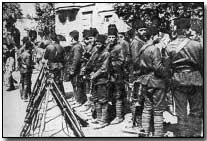Battles - The Battle of Ramadi, 1917
 Having paused to regroup and
recover from the generally successful if costly March-April 1917
Samarrah Offensive,
regional British Commander-in-Chief
Sir Frederick
Stanley Maude renewed operations in Mesopotamia - modern-day Iraq - towards
the end of September 1917.
Having paused to regroup and
recover from the generally successful if costly March-April 1917
Samarrah Offensive,
regional British Commander-in-Chief
Sir Frederick
Stanley Maude renewed operations in Mesopotamia - modern-day Iraq - towards
the end of September 1917.
His first target was the flood-control station at Ramadi, situated on the right bank of the River Euphrates and garrisoned by a large Turkish force. An earlier somewhat half-hearted attempt to seize the town had failed in July, beaten off by the searing heat and a well-organised defence.
Maude's second effort in September 1917 was rather better planned however. He despatched a division to march almost 100km northwest to Ramadi, amply supported by armoured cars. They opened the attack on 28 September on the east bank of the Euphrates against Ramadi's garrison of 4,000 (reinforced from 1,000 during the earlier summer attack).
While the Turkish defenders were in readiness for an attack conducted at the river bank itself they were unprepared for the use of armoured cars, which enabled the British to rapidly attack the Turkish force in the flank, while cavalry was despatched to circle round Ramadi, thereby cutting off the road to Hit (and once in place the cavalry doubled up as an able infantry force).
In short the Turkish garrison was encircled as the British seized numerous ridges above the town. An escape attempt by the garrison force on the night of 28 September was promptly overhauled by cavalry. Thoroughly outmanoeuvred the Turks surrendered on the morning of 29 September in what was an unusually decisive (for this theatre) and encouraging start to Maude's autumn campaign.
Follow-up attempts to capture Hit itself (between Turk forces on the Rivers Euphrates and Tigris) by armoured cars failed on account of predictably poor road surfaces; it was called off before it reached the town.
Nevertheless, having comfortably succeeded in capturing Ramadi Maude next turned his attention to capturing Tikrit in early November.
Click here to view a map charting operations at the time of the fall of Baghdad.
Photograph courtesy of Photos of the Great War website
"Harry Tate" was the nickname given by British pilots to the R.E.8 aircraft
- Did you know?
